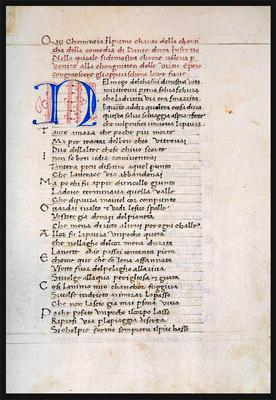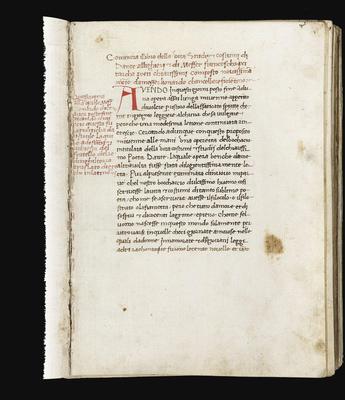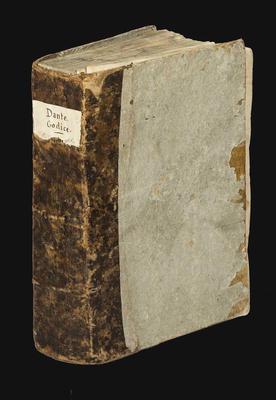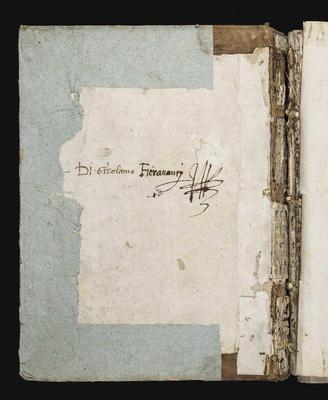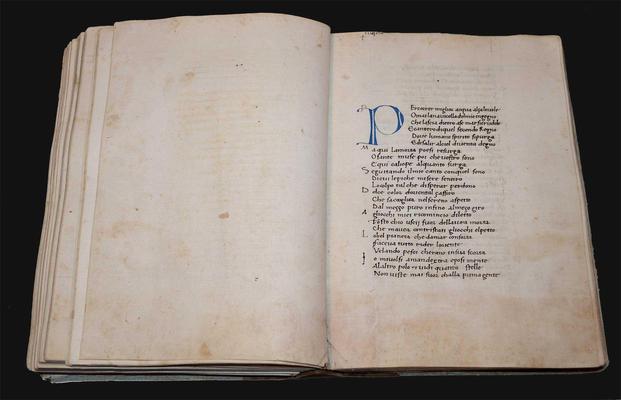Dante Alighieri
Commedia. With encomiastic and exegetical works relating to Dante.
Decorated manuscript on paper. Italy (probably Florence), second half of the fifteenth century (after 15 May 1456).276x195 mm.ii+294+iiileaves. Twenty-four quires, plus a single leaf at the end. Collation: 1-510, 6-1216, 136, 14-1816, 194, 20-2310, 242-1(probably lacking the blank conjugate leaf). Blanks: fols. 8v, 9, 10, 47v-50, 62v, 144-146, 155, 166-168, 251-252. Early inked foliation in the upper right corner, partly trimmed. Text block: single column with variable number of lines and text space measures. Blind ruled, fols. 51r-72r ruled in plummet. Catchwords written in the inner lower margin. Text written in a humanist script, with littera textualis features, hand and ink the same throughout. Six-line pen-flourished initials at the beginning of each cantica; two, three or four line pen-flourished initials alternately in red or blue, traces of guide letters. In the text of the Commedia the first capital letter of the first verse of every terzina set out. Eighteenth-century écaillé half-leather, pasteboards covered with blue paper (abrased in places). Smooth spine, at the top ‘Dante Codice', inked on paper label. Spine partly detached; quires 4-6 slightly loose; some leaves mounted on reinforcing paper strips.
Provenance: the Jesuit theologian Girolamo Fioravanti (1555-1603; ownership inscription on the front pastedown, ‘Di Girolamo Fioravantj'); the Dante scholar from Verona Giovanni Jacopo Dionisi (1724-1808; in his hand the description of this manuscript and some notes written about 1794 on loose leaves inserted in the volume; on a slip ‘Questo codice va d'accordo con quello della Laurenz. Pl.lxxxx. sup. Cod.cxxxi.'); his nephew Giovanni Francesco Dionisi (nineteenth century; see the letter preserved in the volume, written to him by the count Francesco Ravignani, dated 27 June 1817, in which Ravignani thanks him for the loan of this codex); Livio Ambrogio collection.
A precious composite manuscript or zibaldone, probably produced in the milieu of theStudio Fiorentino, containing an almost complete text of the Commedia (the first two cantiche are complete but the compiler suddenly broke off, in the middle of the verso of the last leaf, the transcription of the Paradiso at verse 192 of Cantoxvii) and supplemented with earlier encomiastic and exegetical texts, reflecting how Dante's poem circulated, and was read and re-interpreted in the fifteenth century. It represents an attempt to create, in a kind of personal notebook, an introductory ‘manual' to the Commedia, and is a striking example of the lasting influence of the earlier fourteenth-century works relating to Dante. The miscellany opens with the sermo or protestatio de iustitia held on 15 May 1456 by Pandolfo de' Pandolfini, a friend of Leonardo Bruni and Giannozzo Manetti. In the first half of the fifteenth century the protestatio de iustitia was a traditional Florentine public ceremony, held – as stipulated in the 1415 Statutes – on the installation of the city's new Priors, who undertook in rhetorical declarations to perform their duties with impartiality and equity. Texts of protestationes are often to be found in the zibaldoni assembled and transcribed by Florentine students, as standard pedagogical practice. This manuscript, written in a single hand in humanistic script, could have been produced after 15 May 1456 in the milieu of the Studio Fiorentino. The group of codices of the Commedia transcribed in humanistic script between 1425 and ca. 1450 is limited, increasing the importance of the manuscript presented here.
The miscellanea dantesca in the strict sense begins on fol. 11r with the Libro della vita, studii costumi di Dante Allighieri [et] di messer Francescho Petrarca, the text of the Vitae of Dante and Petrarch composed in 1436 by Leonardo Bruni (1370-1444). The version included in this manuscript is especially noteworthy: it presents vernacular marginal glosses in red ink, identical in content to those extant in a manuscript of Bruni's Vita di Dante copied in 1440 by the Florentine notary and reader of Dante, Piero Bonaccorsi, or Bonaccorso da Montemagno (1410-1477), preserved in the Biblioteca Laurenziana in Florence (msPlut.90 sup. 131, fols. 81v-86v).
Bruni had carefully read Boccaccio's Trattatello in laude di Dante, and in the proemio comments critically on numerous details of this earlier work. It is no coincidence that, following Bruni's account, the unknown compiler of this zibaldone copied an excerpt from the first redaction of the Trattatello (dated between 1351 and 1355; Boccaccio's autograph is preserved in the Biblioteca Capitolar in Toledo,msZelada 104.6), containing the famous description of Dante's appearance: a choice that mirrors the popularity of Boccaccio's work in Florence in the fifteenth century.
The cantiche of the Commedia are introduced by the prologue known as Dante poeta sovrano, a summary of the Expositiones et glose super Comediam Dantis by the Carmelite monk Guido da Pisa (1333-1340), surviving in just seven manuscripts and first published in the 1478 Milanese edition of the Commedia, edited by Martino Paolo Nibia of Novara (known as Nidobeato). The prologue is here followed by the very well-known capitoli on the first cantica composed in the fourteenth century by Jacopo Alighieri – one of Dante's own sons, and the first commentator of the Inferno – and Bosone da Gubbio, both included in many fifteenth-century codices of the Commedia, and printed for the first time in the Venetian edition of Dante of 1477.
The last exegetical text transcribed is the topographical work Cammino di Dante composed ca. 1440 – surviving in a very restricted number of manuscripts – by the aforementioned Piero Bonaccorsi, introduced by Bonaccorsi's letter to the friar Romolo de' Medici, and revealing the peculiarly Florentine interest in geographical and cosmographical questions arising from the Commedia, and particularly in calculating the physical dimensions of Dante's Hell.
The section of the Cammino di Dante devoted to the Inferno ends with the note: “Seguita questo tractato over chamino nel purghatorio et poi nel paradiso. Et se tu lectore disideri vederlo in perfectione cerchalo altrove che qui non lo seguito perché questo volume non contiene più che lo inferno chome vedi pel testo”, i.e. “This treatise called Cammino goes on to describe the journey through Purgatory and Paradise. And if you, my reader, wish to read the complete work, you will need to look for it elsewhere as I haven't transcribed the rest. The volume I'm copying from contains only the Inferno as you see from the text”.Thus the Purgatorio and part of the Paradiso (cantosi-xvii192) were added from other sources by the anonymous copyist/compiler.
The lacuna, starting in the middle of the verso of the last leaf, of the last cantos of the Paradiso shows that this manuscript is unfinished rather than imperfect, either because these cantos were missing in the antigraph the copyist used or for other unknown reasons.
This zibaldone dantesco belonged in the eighteenth century to the renowned Dante scholar from Verona Giovanni Jacopo Dionisi. He was responsible for the edition of the Commedia published by Bodoni (1795), and assembled a vast Dante collection, also including the superb copy of the 1472 Mantuan edition of the Commedia, owned by the dedicatee of the edition Filippo Nuvoloni himself, one of the fifty books presented in this catalogue.


